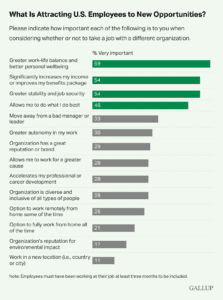Successful companies recognize the immense value of cultivating a positive workplace environment. From enhanced performance and customer service to increased productivity and reduced turnover, the benefits are far-reaching.
Research, including studies from Gallup, highlights the significant impact of workplace culture on employee retention. In 2024, four times as many individuals left their jobs due to a negative culture or poor well-being and work-life balance compared to those who left over salary issues. Furthermore, 59% of those seeking new opportunities cited the desire for “greater work-life balance and better personal well-being” as their primary motivation.
A company’s culture can either attract and retain or deter and discourage. So, how can you develop a healthy, positive work environment? Below are six effective strategies.
Strategies to Foster a Positive Workplace Culture
Creating a positive culture goes beyond mere promises; employees can tell when a company is more talk than action. True progress requires actionable steps that align with a company’s core values and mission statements. With the right commitment and approach, any company can make strides towards a more positive culture. Key strategies include:
- Strengthen manager-employee relationships. Cultivate a culture of open communication and mutual respect. Supportive, transparent interactions between staff and management discourage negative practices such as micromanagement and favoritism.
- Prioritize effective training and coaching. Invest in comprehensive training programs that include both job-specific and soft skills. These initiatives ensure that employees are well-equipped and confident in their roles.
- Communicate your vision and values. Ensure that the organization clearly expresses its vision and values and integrates them into all aspects of operations. This alignment helps employees feel connected to the bigger picture and understand their role within it.
- Implement employee recognition. Develop a consistent and fair recognition system to celebrate employees who demonstrate the company’s values. Recognition fosters a sense of accomplishment and belonging among team members.
- Address performance issues promptly. Uphold high standards by swiftly addressing performance or behavioral issues. It’s important to take corrective action or provide extra support and training. This helps build a culture of accountability and continuous improvement.
- Promote work-life balance. Create an environment that values employees’ personal time. Encourage managers and those in leadership roles to set an example, utilizing their vacation and sick days. This is particularly challenging but important in industries like manufacturing, where shift work and frequent overtime are the norm.
A Worthwhile Investment
At the heart of a positive work environment is leadership that genuinely cares. Leaders who care about their team’s well-being try to understand and support their employees, promote open and honest communication, and consider the needs and values of those they lead.
This investment in employee well-being and success is crucial, as it leads to increased engagement and stronger retention. Among employees committed to staying in their current roles, the primary factor influencing their decision is feeling appreciated and valued. Investing in your people is, without a doubt, the most critical investment you can make.
Connect with a Pinion HR business consultant to discuss employee retention strategies.










